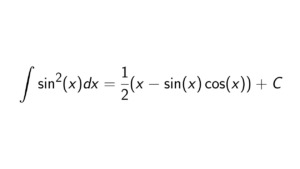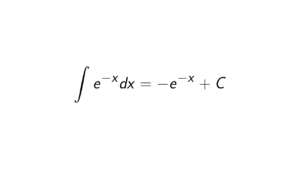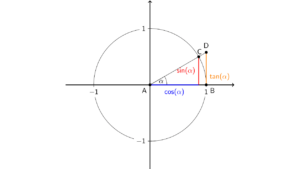Finding a minor of a n \times n matrix is easy, and the steps are almost the same like finding a determinant. It is the first step to find a cofactor matrix. We will start in this article with the general form of finding a minor, how to find a minor of a 2 \times 2, 3 \times 3, and 4\times 4 matrix, where each section ends with an example.
What are the minors of a matrix
Let A be a n \times n matrix. Specifically:
A = \begin{bmatrix}\begin{array}{cccc} a_{1,1} & a_{1,2} & \cdots & a_{1,n} \\ a_{2,1} & a_{2,2} & \cdots & a_{2,n} \\ \vdots & \vdots & \ddots & \vdots \\ a_{n,1} & a_{n,2} & \cdots & a_{n,n} \end{array}\end{bmatrix} The minor M_{i,j} of A is the determinant of n-1 \times n-1 submatrix A, where the ith row and jth column are deleted. In mathematical notation, we will get
M_{i,j} = \begin{vmatrix} a_{1,1} & a_{1,2} & \cdots & a_{1,j-1} & a_{1,j+1} & \cdots & a_{1,n} \\ a_{2,1} & a_{2,2} & \cdots & a_{2,j-1} & a_{2,j+1} & \cdots & a_{2,n} \\ \vdots & \vdots & \ddots & \vdots & \vdots & \cdots & \vdots \\ a_{i-1,1} & a_{i-1,2} & \cdots & a_{i-1,j-1} & a_{i-1,j+1} & \cdots & a_{i-1,n} \\ a_{i+1,1} & a_{i+1,2} & \cdots & a_{i+1,j-1} & a_{i+1,j+1} & \cdots & a_{i+1,n} \\ \vdots & \vdots & \cdots & \vdots & \vdots & \ddots & \vdots \\ a_{n,1} & a_{n,2} & \cdots & a_{n,j-1} & a_{n,j+1} & \cdots & a_{n,n} \end{vmatrix} Finding all minors of a matrix A, and plugging them together in a new matrix is called the matrix of minors, which we will denote as M:
M = \begin{bmatrix}\begin{array}{cccc} M_{1,1} & M_{1,2} & \cdots & M_{1,n} \\ M_{2,1} & M_{2,2} & \cdots & M_{2,n} \\ \vdots & \vdots & \ddots & \vdots \\ M_{n,1} & M_{n,2} & \cdots & M_{n,n} \end{array}\end{bmatrix} In the end, it is almost the same as calculating the determinant. The only difference is that we need to delete one row and one column. We will do some examples in the next sections for more clearness.
How to find the minors of a 2×2 matrix?
We will be starting by finding minors of a 2\times 2 matrix. So let A be 2\times 2 matrix. Specifically:
A = \begin{bmatrix}\begin{array}{cc} a_{1,1} & a_{1,2} \\ a_{2,1} & a_{2,2} \end{array}\end{bmatrix} For each minor M_{1,1}, M_{1,2}, M_{2,1} and M_{2,2}, we need to find it’s determinant of the 1\times 1 submatrix of A. But 1\times 1 matrix is one element. Therefore, we can rewrite the minors as:
\begin{equation*} M_{1,1} = a_{2,2}, \quad M_{1,2} = a_{2,1}, \quad M_{2,1} = a_{1,2}, \quad \text{and} \quad M_{2,2} = a_{1,1} \end{equation*} M = \begin{bmatrix}\begin{array}{cc} M_{1,1} & M_{1,2} \\ M_{2,1} & M_{2,2} \end{array}\end{bmatrix} = \begin{bmatrix}\begin{array}{cc} a_{2,2} & a_{2,1} \\ a_{1,2} & a_{1,1} \end{array}\end{bmatrix} A = \begin{bmatrix}\begin{array}{cc} 5 & -2 \\ 7 & 3 \end{array}\end{bmatrix} \ \Rightarrow \ M = \begin{bmatrix}\begin{array}{cc} 3 & 7 \\ -2 & 5 \end{array}\end{bmatrix} How to find the minors of a 3×3 matrix?
Now we need to perform more calculations since we have 9 determinants. Concretely, let A be the matrix
A = \begin{bmatrix}\begin{array}{ccc} a_{1,1} & a_{1,2} & a_{1,3} \\ a_{2,1} & a_{2,2} & a_{2,3} \\ a_{3,1} & a_{3,2} & a_{3,3} \end{array}\end{bmatrix}Then the matrix of minors of A is
M = \begin{bmatrix}\begin{array}{ccc} M_{1,1} & M_{1,2} & M_{1,3} \\ M_{2,1} & M_{2,2} & M_{2,3} \\ M_{3,1} & M_{3,2} & M_{3,3} \end{array} \end{bmatrix} \quad = \begin{bmatrix}\begin{array}{ccc} \begin{vmatrix} a_{2,2} & a_{2,3}\\ a_{3,2} & a_{3,3}\\ \end{vmatrix} & \begin{vmatrix} a_{2,1} & a_{2,3}\\ a_{3,1} & a_{3,3}\\ \end{vmatrix} & \begin{vmatrix} a_{2,1} & a_{2,2}\\ a_{3,1} & a_{3,2}\\ \end{vmatrix} \\\\ \begin{vmatrix} a_{1,2} & a_{1,3}\\ a_{3,2}& a_{3,3}\\ \end{vmatrix} & \begin{vmatrix} a_{1,1} & a_{1,3}\\ a_{3,1}& a_{3,3}\\ \end{vmatrix} & \begin{vmatrix} a_{1,1} & a_{1,2}\\ a_{3,1}& a_{3,2}\\ \end{vmatrix} \\\\ \begin{vmatrix} a_{1,2} & a_{1,3}\\ a_{2,2}& a_{2,3}\\ \end{vmatrix} & \begin{vmatrix} a_{1,1} & a_{1,3}\\ a_{2,1}& a_{2,3}\\ \end{vmatrix} & \begin{vmatrix} a_{1,1} & a_{1,2}\\ a_{2,1} & a_{2,2}\\ \end{vmatrix} \end{array} \end{bmatrix} A = \begin{bmatrix}\begin{array}{ccc} 3 & -1 & 6 \\ 2 & 5 & 7 \\ 1 & -3 & 1 \end{array} \end{bmatrix} \ \Rightarrow \ M = \begin{bmatrix}\begin{array}{ccc} 26 & -5 & -11 \\ 17 & -3 & -8 \\ -37 & 9 & 17 \end{array}\end{bmatrix} How to find the minors of a 4×4 matrix?
We saw in the previous sections that finding a minor is quite an easy and straightforward calculation. To tackle the 4 \times 4 matrix, we need to calculate 16 determinants of 3\times 3 submatrices. That is a lot of calculations! Normally, that would be done by computers, but here, we will give a few calculations how to find minors of a 4 \times 4 matrix.
A = \begin{bmatrix}\begin{array}{cccc} 3 & -1 & 6 & 2 \\ 2 & 5 & 7 & 4 \\ 1 & -3 & 1 & 9 \\ 4 & 1 & 3 & 7 \end{array}\end{bmatrix} M_{1,1} = \begin{vmatrix} 5 & 7 & 4\\ -3 & 1 & 9\\ 1 & 3 & 7 \end{vmatrix} = 5 \cdot \begin{vmatrix} 1 & 9\\ 3 & 7 \end{vmatrix} + 3 \cdot \begin{vmatrix} 7 & 4\\ 3 & 7 \end{vmatrix} + 1 \cdot \begin{vmatrix} 7 & 4\\ 1 & 9 \end{vmatrix} = 5 \cdot (-20) + 3 \cdot 37 + 1 \cdot 59 = 70
M_{4,2} = \begin{vmatrix} 3 & 6 & 2 \\ 2 & 7 & 4 \\ 1 & 1 & 9 \\ \end{vmatrix} = 3 \cdot \begin{vmatrix} 7 & 4 \\ 1 & 9 \\ \end{vmatrix} - 2 \cdot \begin{vmatrix} 6 & 2 \\ 1 & 9 \\ \end{vmatrix} + 1 \cdot \begin{vmatrix} 6 & 2 \\ 7 & 4 \\ \end{vmatrix} = 3\cdot 59 - 2 \cdot 52 + 1 \cdot 14 = 83
Conclusion
Finding minors of a matrix can be done easily and quickly for matrices of 2 \times 2 and 3 \times 3, but bigger than that will increase the complexity of calculations. In the end, minors can be quite handy to find the inverse matrix.


